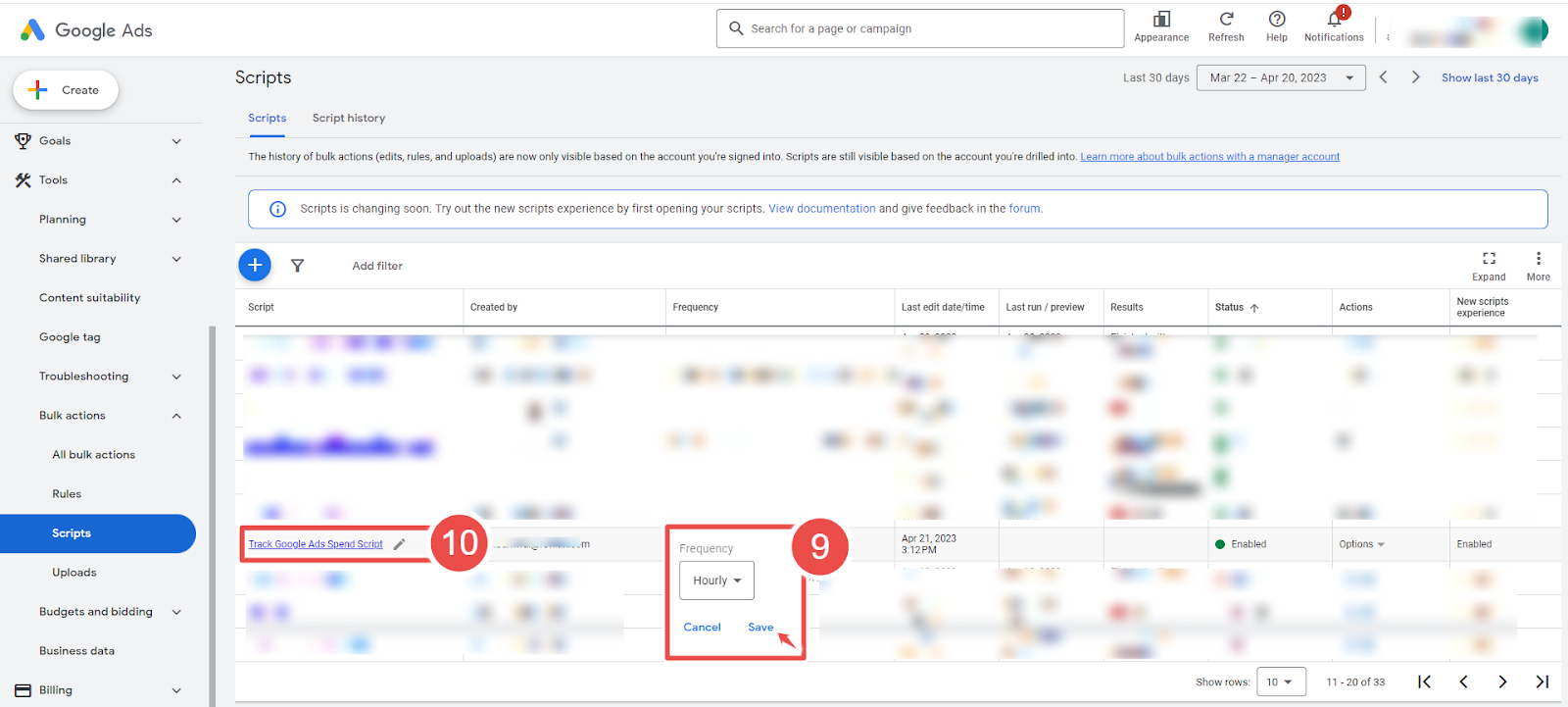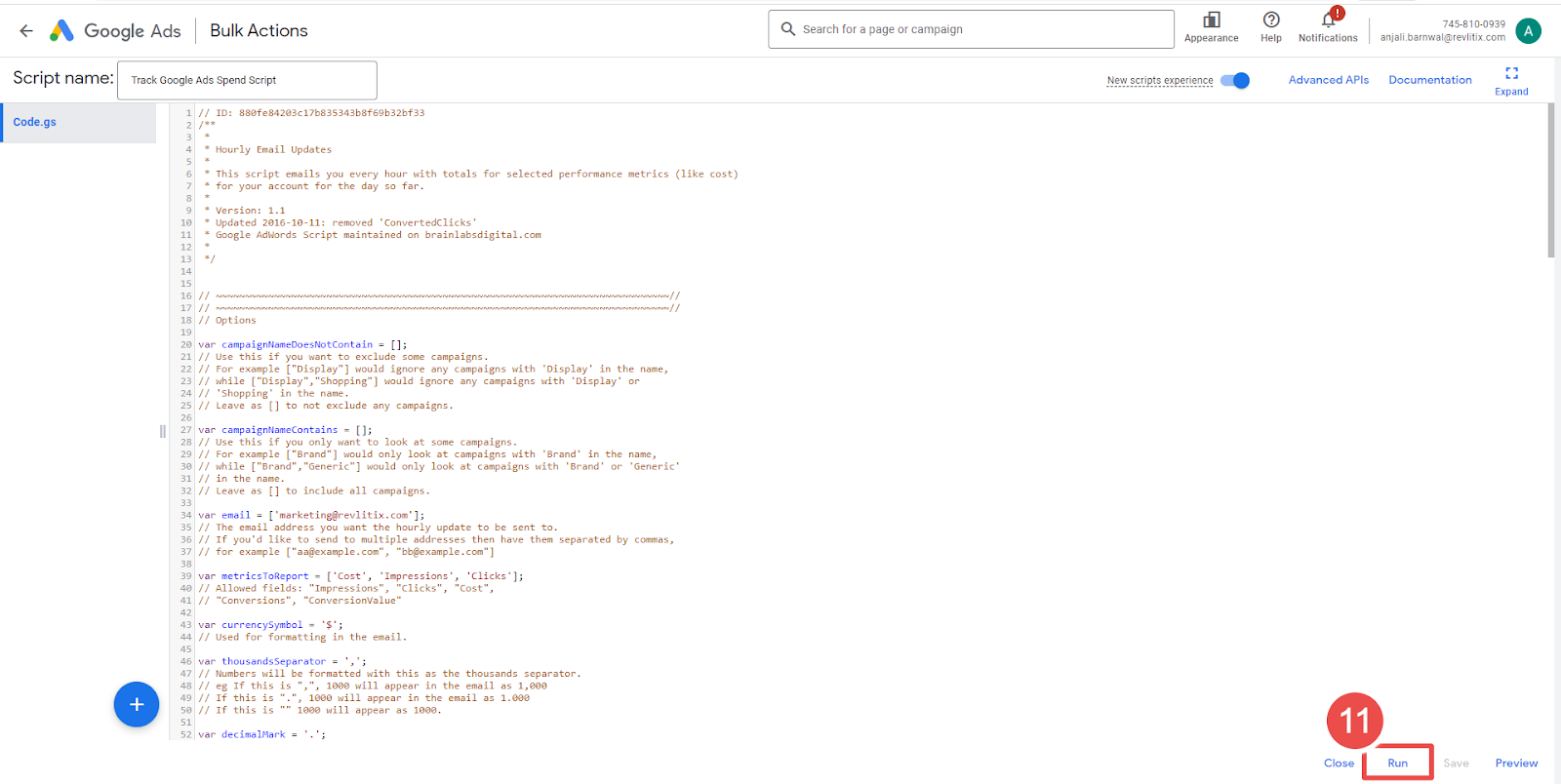Managing a PPC account is not just about expertise; it requires staying up-to-date with market changes. It's like riding a rollercoaster with unpredictable ups and downs that need constant attention to succeed.
The "Track Google Ads Spend" script is a handy tool to help you monitor your Google Ads spending. It lets you set a budget limit for your campaigns, and when your spending hits a certain level, it sends you an email notification.
This way, you can avoid over your budget and keep better control of your ad spend. Additionally, the script can also help you identify trends in your spending over time so that you can adjust your campaigns accordingly.
By using this script, you can optimize your Google Ads performance and get the most out of your advertising budget. It's a useful tool for anyone who wants to manage their ad spend more efficiently and get better results from their Google Ads campaigns.
How does the script work?
The "Track Google Ads Spend" script is a tool that can help you keep track of your Google Ads spending and performance metrics. It operates by sending you hourly email updates with the latest data on your spending, clicks, impressions, and conversions.
Using this script, you can monitor your ad spend closely and prevent overspending by setting a budget limit for your campaigns. If your spending exceeds your set limit, you'll receive an email notification, allowing you to take prompt action and avoid going over budget.
The script also provides insights into your campaign's performance by tracking metrics such as clicks, impressions, and conversions. This information can help you optimize your ad campaigns and make data-driven decisions to improve their effectiveness.
Overall, the "Track Google Ads Spend" script is a valuable tool for anyone who wants to manage their Google Ads spending more efficiently and get better results from their ad campaigns.
Before setting up the script, get familiar with the interface and navigation in Google ads.

- Tools- The Tools tab provides direct links to various Google Ads account tools. Use these tools to monitor and make changes to your account, ads, ad groups, and keywords.
- Bulk actions- It allows advertisers to modify multiple campaigns, ad groups, ads, or keywords in a single action, saving time and effort.
- Scripts- It allows advertisers to automate and customize their bulk actions. This tool allows advertisers to create custom scripts that perform specific actions on their campaigns or accounts, such as updating bids, pausing underperforming ads, or adding new keywords.
- + button- It allows advertisers to create new scripts.

- New Script- It allows advertisers to create a new script from scratch.

- Add Script Name- It allows advertisers to name their scripts.
- Authorize- It allows advertisers to grant permission for their script to access their Google Ads account.
- Save- It allows advertisers to save their scripts after making changes or creating new ones.

- Frequency- It allows advertisers to set how often a script runs.
- Script - Given script name is Track Google Ads Spend Script.

- Run- It allows advertisers to execute a script.


- Logs- The log statement in Google Ads Script Tools is used to output messages to the script's log, helping advertisers track progress, troubleshoot issues, and create custom reports.
Steps to add the Track Google Ads Spend Script in Google Ads:
Step-1 Log in to your Google Ads account and navigate to the "Bulk Actions" tab.
Step-2 Choose "Scripts" from the drop-down menu.
Step-3 Click on the "Add" button to create a new script.
Step-4 Copy and paste the Campaign Spending Alert Script.
--> Change a couple of settings in the script:
- To exclude certain campaigns from metrics reporting, you can use the campaignNameDoesNotContain parameter with a list of phrases to exclude, such as ["Display"] or ["Display," "Shopping"]. Alternatively, you can use the campaignNameContains parameter to include specific campaigns or leave both parameters empty to include all campaigns.
- The important one is email: Change this to your email address or a list of email addresses. It's recommended to use only your email address during initial testing and add other recipients once you're sure the script is working.
- Use the metricsToReport parameter to specify which metrics to report. For example, ["Cost," "Clicks," "Impressions"] will report cost, clicks, and impressions, while ["Cost"] will report only cost.
Available options include "Impressions," "Clicks," "Cost," "ConvertedClicks," "Conversions," and "ConversionValue."
- Note that there may be a delay for conversion data (even longer than for Google Ads data in general). If you get conversions from Analytics, you could wait an entire day. So be careful if you are reporting these.
- Specify a currencySymbol to appear before any currency values (such as costs and conversion values) in the email.
- Use the thousandsSeparator and decimalMark parameters to format numbers. For example, if thousandsSeparator is set to "," and decimalMark is set to ".", numbers will appear as "1,234.56." Alternatively, if thousandsSeparator is set to "." and decimalMark is set to, ", numbers will appear as "1.234,56."
Step-5 Next, click the "Authorize" button to authorize the script to access your account.
Step-6 Click on the "Save."
Step-7 Go back to the "Scripts" section and find the "Track Google Ads Spend Script" script at the top of the list.
Step-8 Then, set the frequency at which you want the script to run (suggested to run it hourly).
Step-9 Then click on Track Google Ads Spend Script.
Step-10 “Run the script.”
Step-11 Once the script has finished running, click on the "Logs" button to see the results.
The logs will show you the date and time the script ran, any errors that occurred, and any email alerts that were sent.
Here are a few important points to keep in mind regarding the script:
1. Any emails the script sends will appear as if they are from you.
2. The definition of "today" depends on the time zone of your Google Ads account. Additionally, the time indicated in the email is based on the account's time zone.
3. There is a delay of approximately 20 minutes before Google Ads receives data. Therefore, if the script runs at 10:20, it will likely only have complete data up until 10:00 for that day.
4. The report contains information on both paused and deleted campaigns and active ones. This is because any money spent on advertising is not refunded simply because a campaign has been deleted or paused.









